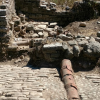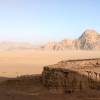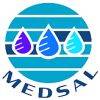This is an old revision of the document!
Projects
Water Supply of Ancient Cities
 Water and cult of the Heraion: German Research Foundation (DFG) 2016-2019, project in cooperation with DAI (German Archeological Institute) on the paleo- und modern hydrology and hydrogeology of the ancient temple of Hera site. The site is affected by recurrent inundation and flooding. The hydrological processes and water balance of the site is established in order to better understand the ancient water supply system, its vulnerability to droughts and floods and in order to establish the causes and mitigate the impact of flooding at the modern site. A bibliography of studies on this archeological site with special reference to the hydrological can be found at our bibsonomy group
Water and cult of the Heraion: German Research Foundation (DFG) 2016-2019, project in cooperation with DAI (German Archeological Institute) on the paleo- und modern hydrology and hydrogeology of the ancient temple of Hera site. The site is affected by recurrent inundation and flooding. The hydrological processes and water balance of the site is established in order to better understand the ancient water supply system, its vulnerability to droughts and floods and in order to establish the causes and mitigate the impact of flooding at the modern site. A bibliography of studies on this archeological site with special reference to the hydrological can be found at our bibsonomy group
- groundwater model of Heraion site
- coupling to hydrological model
- scenario analysis of ancient droughts and floods
- concept to reduce flooding
ISOMED
 The project ISOMED aims at developing innovative methods for estimating environmental flows with the ultimate objective of increasing water use efficiency and reaching sustainability. Sustainability is defined as resilient balance of water resources renewal and uses within hydrological systems under anthropogenic pressure at various scales.
The project ISOMED aims at developing innovative methods for estimating environmental flows with the ultimate objective of increasing water use efficiency and reaching sustainability. Sustainability is defined as resilient balance of water resources renewal and uses within hydrological systems under anthropogenic pressure at various scales.
- sites in Cyprus and Jordan
- novel recharge estimation methods
- participative soil water monitoring
- water flow accounting
Project coordination with Collabtive
MEDSAL
 : The MEDSAL Project aims to secure the availability and quality of groundwater reserves in Mediterranean coastal areas, which are amongst the most vulnerable regions in the world to water scarcity and quality degradation. This will be addressed by providing a novel holistic approach, towards the sustainable management of coastal aquifers, which are affected by increased (single or multi-induced) groundwater salinization risk, especially under the variable meteo-climatic conditions of the Mediterranean and the rapidly changing socio-economic context.
: The MEDSAL Project aims to secure the availability and quality of groundwater reserves in Mediterranean coastal areas, which are amongst the most vulnerable regions in the world to water scarcity and quality degradation. This will be addressed by providing a novel holistic approach, towards the sustainable management of coastal aquifers, which are affected by increased (single or multi-induced) groundwater salinization risk, especially under the variable meteo-climatic conditions of the Mediterranean and the rapidly changing socio-economic context.
- Deliver new tools for the identification of variable (multi-induced) and often cascading salinization sources and processes
- Derive, build and integrate coherent and robust datasets of critical parameters related to GWS, especially in areas of insufficient and/or negligible availability
- Couple physical-based models (hydrogeological and hydrogeochemical), environmental isotopes, advanced geostatistical methods and artificial intelligence (AI) techniques (shallow and deep learning) to develop novel approaches and methods in the simulation and forecasting of GWS
- Identify new patterns and develop new proxies for monitoring, assessment, and forecasting of GWS in areas with scarce data and/or limited financial and human resources
- Elaborate tailor-made risk assessment and management plans by coupling GWS forecasts with climate change impacts and future scenarios
- Develop a public domain web-GIS Observatory (MOb) for monitoring, alerting, decision support and management of coastal groundwater reserves around the Mediterranean
- Facilitate public participation and enhance the active engagement of local societies to dataset development and monitoring
- Facilitate fusion of expertise among academia and stakeholders (national level) and transfer of technology and know-how among the participating countries (international level), including cross-training on methods, tools, and services.
Completed Projects
- Integrated Water Management of the Omaruru Basin: Project with SLR to develop an integrated water management model of the Omaruru Basin in Namibia
- Water Quality Accounts for the Swakop Basin: Project with SLR to develop a water quality accounting system - case study in the Swakop Basin / Namibia.
- Water Accounts: Methodology for Developping Water Accounts - Pilot and Capacity Building.
- SEA: Strategic Planning of Water Resources of the Erongo Region. BIWAC, GSN, DWA, BGR. October 2010 until March 2011.
- WADE
- ITER
- GREM - Groundwater Resources in the Eastern Mediterranean
